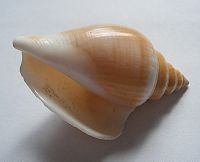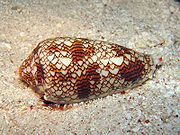- Laevistrombus canarium
-
Laevistrombus canarium Five views of a shell of the dog conch Scientific classification Kingdom: Animalia Phylum: Mollusca Class: Gastropoda (unranked): clade Caenogastropoda
clade Hypsogastropoda
clade LittorinimorphaSuperfamily: Stromboidea Family: Strombidae Genus: Laevistrombus Species: L. canarium Binomial name Laevistrombus canarium
(Linnaeus, 1758)Synonyms[1][2] Laevistrombus canarium, commonly known as the dog conch and still better known under its synonym Strombus canarium, is a species of edible sea snail, a marine gastropod mollusk in the family Strombidae, the true conchs. An Indo-Pacific species, L. canarium lives on mud and sandy bottoms, grazing on algae and detritus. The shell of adult individuals is colored light yellowish-brown to golden to gray. It has a characteristic inflated body whorl, a flared and thick outer lip, and a shallow stromboid notch. Although it is considered to have value as an ornament, because the shell is heavy and compact it is often used as sinker for fishing nets.
The external anatomy of the soft parts of this species is similar to that of other strombid snails; the animal has an elongate snout, thin eyestalks with well-developed eyes and sensory tentacles, and a narrow, strong foot with a sickle-shaped operculum attached. Among the predators of this snail are carnivorous gastropods such as cone snails and volutes, as well as humans, who consume the soft parts in a wide variety of dishes.
The dog conch is an economically important species in the Indo-West Pacific, and several studies indicate that it may be currently suffering population declines due to overfishing and overexploitation.[3][4] Malacologists and ecologists have recommended the reduction of the current exploitation rates; recent initiatives in Thailand are attempting to ensure the reproduction of younger individuals, as well as managing the natural populations in general.
Contents
Taxonomy and naming
The first published depictions of the shell of Laevistrombus canarium appeared in 1684, in the earliest book that was solely about sea shells, Recreatio mentis et oculi in observatione animalium testaceorum (translation: Refreshment of the mind and the eye in the observation of shell-bearing animals) by the Italian scholar Filippo Buonanni.[5] The species was shown in the 1742 Index Testarum Conchyliorum, quae adservantur in Museo Nicolai Gualtieri (translation: List of the shells of shellfish which are preserved in the museum of Niccolò Gualtieri) by the Italian physician and malacologist Niccolò Gualtieri. In both books the morphology of an adult dog conch shell was shown from different perspectives.[5]
In 1758, the dog conch was formally described by the Swedish naturalist and taxonomist Carl Linnaeus. The specific name canarium is derived from the Latin word canis and its root can, meaning dog.[6] The original description given by Linnaeus in the book Systema Naturae is written in Latin, and reads as follows: "S. testae labro rotundato brevi retuso, spiraque laevi." This can be translated as Strombus (S.) with a shell (testae) having a retuse (retuso), short (brevi), rounded (rotundato) lip (labro), and (-que) a smooth (laevi) spire (spira). Linnaeus did not mention a specific locality in his original description, giving only Eastern Asia as the area in which the species is found.[7]
The synonyms that are listed in the taxobox are other binomial names that were given over time to this taxon by authors who were not aware that the specimens they were describing belonged to a species that Linnaeus had already described; in some cases they may have been misled into thinking they had a different species because of local variations in color and form. Strombus vanicorensis is a subsequent changed spelling of Strombus vanikorensis by one of the original authors of that species.
In the Malay Peninsula, this species is known by the Malay common names siput gonggong and gong-gong; "siput" means snail and "gonggong" means a dog's bark or howl.[2][8] L. canarium comprises at least two known subspecies, one of them being Laevistrombus canarium canarium (Linnaeus, 1758), and the other one is Laevistrombus canarium guidoi (Man in 't Veld & De Turck, 1998).[9]
Anatomy
Shell description
Laevistrombus canarium has a heavy shell with a rounded outline. The maximum shell length of this species is up to 100 mm (3.9 in), but more commonly it grows to about 65 mm (2.6 in).[1] The outer surface of the shell is almost completely smooth, and unlike species in the genus Strombus, the stromboid notch on the outer lip is quite inconspicuous. When a normal adult dextral shell of this species is viewed ventrally, and with the anterior end pointing downwards, the stromboid notch can be observed to the right of the siphonal canal as a shallow secondary anterior indentation in the lip. The siphonal canal itself is straight, short and ample, and the columella is smooth without any folds.[1] Adult specimens have a moderately flared outer lip,[8] which is considerably thickened and completely devoid of marginal spikes or plicae. The body whorl is roundly swollen at the shoulder, with a few anterior spiral grooves. The shell has a medium to high conoidal spire, with at least five delicately furrowed whorls.[2]
The shell color varies a great deal from golden yellow to light yellowish brown to gray. The underside of the shell is rarely dark, more frequently it is paler or totally white, but in all cases the shell aperture is white. Mature specimens sometimes present a metallic gray or golden brown gloss on the margin of the outer lip and the callus.[1] A zig-zag network of darker brown lines is sometimes present on the outside of the shell, but this is considered to be uncommon.[2]
The periostracum, a layer of protein (conchiolin) which is the outermost part of the shell surface, is yellowish-brown in color, and is usually thick and reticulated (net-like), and is fimbriated (fringed) over the suture.[2] The corneous operculum is dark brown in color. Its shape is fairly typical of the family Strombidae—a slightly bent sickle, with seven to eight weak lateral serrations.[2]
Soft parts
 An illustration depicting the external morphology of L. canarium, from Manual of Conchology (1885)[10]
An illustration depicting the external morphology of L. canarium, from Manual of Conchology (1885)[10]
Female individuals of Laevistrombus canarium are generally larger (both shell and soft parts) than male individuals, as is the case in other strombid gastropods, among them the spider conch Lambis chiragra and the queen conch Eustrombus gigas.[4] The external anatomy of the soft parts of this species is very similar to that of the other members of the family: the animal has a long extensible snout and thin eyestalks (also known as ommatophores) having at the tips well developed lens eyes. Each eyestalk has, branching off near the end, a small sensory tentacle. The large foot of the animal is narrow and strong, and is able to perform the leaping form of locomotion which also occurs in other species of Strombidae such as the queen conch E. gigas.[8]
Phylogeny
Strombus maculatus
Strombus mutabilis
Strombus microurceus
Strombus labiatus
Strombus fragilis
Strombus urceus
Strombus dentatus
Strombus canarium
Strombus vittatus
Strombus epidromis
Strombus fusiformis
Strombus haemastoma
Strombus wilsoni
Part of the phylogeny and relationships of Strombus species, according to Latiolais et al. (2006)[11] In 2006, Latiolais and colleagues proposed a cladogram (a tree of descent) that attempts to show the phylogenetic relationships of 34 species within the family Strombidae. The authors analysed 31 species in the genus Strombus including Strombus canarium, and three species in the allied genus Lambis. The cladogram was based on DNA sequences of both nuclear histone H3 and mitochondrial cytochrome-c oxidase I (COI) protein-coding gene regions. In this proposed phylogeny, Strombus canarium, Strombus vittatus and Strombus epidromis are closely related and appear to share a common ancestor.[11]
Distribution
Laevistrombus canarium is native to the coastal waters of the Indo-Pacific region.[3] It occurs in the Indo-Pacific from India and Sri-Lanka to Melanesia, southern Japan and northern Australia.[1] Regions and countries where this species has been recorded include:[2]
Tanjung Adang Shoal, Merambong Shoal, Tanjung Bin, Tanjung Surat and Pasir Gogok in the Johor Straits; Records also include Pulau Tinggi, Pulau Besar and Pulau Sibu, Port Dickson and Teluk Kemang in eastern Johor and Negeri Sembilan, as well as Pulau Pangkor, Pulau Langkawi, Cape Rachado, Kilat, and western Johor Straits. The dog conch has also been recorded in Thailand, Indonesia and Vietnam.
Behavior
Compared to other gastropods, Laevistrombus canarium has a rather unusual means of locomotion, which is common only among the Strombidae. This curious series of maneuvers was first described by the American zoologist George Howard Parker (1864–1955)[12] in 1922. The animal first fixes the posterior end of the foot by having the point of the sickle-shaped operculum thrust into the substrate. Then it extends its foot forward, further lifting the shell and throwing it ahead in a so-called leaping motion.[8][13]
Burrowing behavior, in which an individual sinks itself entirely or partially into the substrate, is frequent among strombid gastropods.[14] The burrowing behavior of S. canarium consists of a series of movements which are characteristic of the species. There are three consecutive phases: first the probing phase, in which the animal thrusts the anterior portion of the foot into the substrate to gain hold; then the shoveling phase, in which it pushes the substrate using the long extensible proboscis, and then finally the retracting phase, in which it moves the shell along an anterior-posterior axis in order to settle the substrate around it. Usually some of the dorsal portion of the shell is still visible, even though the ventral surface and the animal's soft parts are buried.[14]
The escape response in gastropods, which consists of the perception of stimuli (for example, the presence of a predator nearby) and a subsequent escape motion, is a frequent target of behavioral studies.[15] In gastropods, the perception of environmental chemical stimuli originating, for example, from food or other organisms, is possibly mediated by sensory organs such as the osphradium.[16] In the case of S. canarium, the perception of a predator can occur either chemically or by vision, which is well-developed in strombid gastropods. The presence of a predator can significantly alter the movement pattern of S. canarium, inducing an increase in the frequency of leaps.[15]
Ecology
The dog conch lives on muddy sand bottoms among algae and seagrass beds of insular and continental shores, and usually prefers major islands and continental coasts rather than the shores of small islands, though this may not be an absolute rule.[1][8][17] It can be found in both the littoral and sublittoral zones, from shallow waters to 55 m (180&n bsp;ft) depths.[1] S. canarium is normally found in large colonies,[18] and is usually abundant wherever it occurs.[19]
Strombid gastropods were commonly accepted as carnivores during the 19th century. This erroneous conception was based on the writings of the French naturalist Jean Baptiste Lamarck, who classified strombids alongside other supposedly carnivorous snails. However, subsequent studies have refuted the concept completely, and proved that strombid gastropods are herbivorous animals.[20] Nowadays, as is the case in other Strombidae, Laevistrombus canarium is known to be a herbivore,[19] feeding on algae, and occasionally on detritus.[8]
Many carnivorous marine gastropod snails are known predators of S. canarium, including the volutes Cymbiola nobilis and Melo melo,[4] and the cone snail Conus textile.[15]
Life cycle
Laevistrombus canarium is gonochoristic,[19][21] which means that each individual animal is either distinctly male or female. The breeding season starts in late November and continues until early March.[22] After internal fertilization, the female of S. canarium produces and spawns a long gelatinous tubular structure containing multiple eggs. This structure then coils itself and compacts to form a creamy-white colored egg mass. Each one of those egg masses may contain about 50–70 thousand eggs,[18] and the females usually lay them on seagrass, where they remain attached.[21] In approximately 110–130 hours, the embryo of L. canarium grows from a single cell to a veliger, a larval form common to various marine and fresh-water gastropod and bivalve mollusks,[16] and then hatches. The hatching process requires 12–15 hours to occur.[18] After hatching, L. canarium larvae can be assigned to four distinct developmental stages throughout their short planktonic life, based on morphological features and other prominent characters. Usually, larvae that are 0–3 days old are Stage I veligers; 4–8 day old larvae are Stage II; 9–16 day old larvae are Stage III, and 17 day old until metamorphosis are Stage IV.[18] L. canarium larvae show a faster development when compared to other species in the same family, among which are the West Indian fighting conch Strombus pugilis, and the milk conch Lobatus costatus. However, larval development may be highly influenced by environmental conditions, such as temperature and the quality and availability of food.[23] The metamorphosis in L. canarium can be recognized by the loss of the larval velar lobes, and by the typical leaping motion of juvenile conchs.[18]
Studies from 2008 indicate that sexual dimorphism occurs very early during this species' ontogeny. L. canarium males reach their sexual maturity at a lower shell length compared to females.[22] Individuals are usually considered to be adult by the time the outer lip of their shell is noticeably thickened and flared; growing to adult size usually takes about a year.[22] The maximum life span of the dog conch differs between sexes, and is estimated at 2 and 2.5 years for females and males respectively.[4]
Human uses and conservation measures
The flesh of the dog conch is edible. It constitutes an important food staple for locals living along the seashore, and is fished in many parts of South East Asia.[3] The meat is used in a wide variety of common dishes, such as soups, cutlets, noodles, curry, and chilli.[24] Despite their considerable ornamental value,[1][25] L. canarium shells are also traditionally used by local fishermen as sinkers for their fishing nets.[1] Studies indicate that L. canarium has been overexploited and overfished recently in many areas, and malacologists and ecologists have recommended the reduction of exploitation rates in order to maintain its availability as a natural resource.[3][4] For instance, dog conchs are now considered rare in Singapore, probably as a result of unsustainable exploitation.[8] Finding large dog conch individuals has become an increasingly difficult task in several regions where this species occurs.[26] Recent initiatives conducted in Phuket (Thailand) intend to increase the depleted natural stocks of L. canarium by reintroducing cultured animals in local seagrass beds. Fishermen are being encouraged not to collect younger, smaller individuals, so that their future reproduction may be assured.[26]
References
- ^ a b c d e f g h i Poutiers, J. M. (1998). "Gastropods". In Carpenter, K. E.. The living marine resources of the Western Central Pacific. Rome: Food and Agriculture Organization of the United Nations (FAO). p. 471. ISBN 92-5-104051-6. ftp://ftp.fao.org/docrep/fao/009/w7191e/w7191e40.pdf.
- ^ a b c d e f g Cob, Z. C.; Arshad, A; Bujang, J. S. & Ghaffar, M. A. (2009). "Species description and distribution of Strombus (Mollusca: Strombidae) in Johor Straits and its surrounding areas". Sains Malaysiana 38 (1): 39–46. http://myais.fsktm.um.edu.my/8228/1/Sains_Malaysiana_Feb2009_Article5.pdf.
- ^ a b c d Cob, Z. C.; Arshad, A; Sidik J. B; Amin, S. M. N. & Ghaffar, M. A. (2008). "Growth, mortality, recruitment and yield-per-recruit of Strombus canarium Linnaeus, 1758 (Mesogastropoda: Strombidae) from the West Johor Straits, Malaysia". Research Journal of Fisheries and Hydrobiology 3 (2): 71–77.
- ^ a b c d e Cob, Z. C.; Arshad, A; Bujang, J. S; Ghaffar, M. A. (2009). "Age, Growth, Mortality and Population Structure of Strombus canarium (Gastropoda: Strombidae): Variations in Male and Female Sub-Populations". Journal of Applied Sciences 9 (18): 3287–3297. doi:10.3923/jas.2009.3287.3297. http://scialert.net/fulltext/?doi=jas.2009.3287.3297.
- ^ a b Buonanni, F. (1684) (in Latin). Recreatio mentis, et oculi in observatione animalium testaceorum Italico sermone primum proposita ... nunc ... Latine oblata centum additis testaceorum iconibus. Romae, Ex typographia Varesii. pp. 431–432 (plates 146 and 147). http://www.archive.org/stream/recreatiomentise00buon#page/n431/mode/2up.
- ^ "Wordinfo.com". http://www.wordinfo.info/words/index/info/view_unit/364. Retrieved 19 April 2010.
- ^ Linnaeus, C. (1758).Systema Naturae, 10th ed., vol. 1. 824 pp. Laurentii Salvii: Holmiae (Stockholm, Sweden). p. 745.
- ^ a b c d e f g "Online guide to Check Jawa: Gong-gong". http://www.wildsingapore.com/wildfacts/mollusca/gastropoda/strombidae/canarium.htm. Retrieved 2009-11-03.
- ^ Laevistrombus canarium (Linnaeus, 1758). Accessed through: World Register of Marine Species at http://www.marinespecies.org/aphia.php?p=taxdetails&id=564722 on 15 April 2011.
- ^ Tryon, G. W. (1885). Manual of Conchology, structural and systematic, with illustrations of the species. Volume 7. p. 350. http://www.archive.org/stream/manualconch07tryorich#page/350/mode/2up.
- ^ a b Latiolais, J. M.; Taylor, M. S; Roy, K. & Hellberg, M. E. (2006). "A molecular phylogenetic analysis of strombid gastropod morphological diversity". Molecular Phylogenetics and Evolution (Elsevier) 41 (2): 436–444. doi:10.1016/j.ympev.2006.05.027. PMID 16839783. http://biology.ucsd.edu/labs/roy/PDFs/Latiolais%20et%20al.%202006%20Mol.%20Phyl.%20&%20Evol.pdf.
- ^ Coan, E. V.; Kabat, A. R.; Petit, R. E. (2010). 2,400 Years of Malacology (7th ed.). American Malacological Society. p. 874. http://www.malacological.org/pdfs/2400years/2400yrs_of_Malacology_complete.pdf.
- ^ Parker, G. H. (1922). "The leaping of the stromb (Strombus gigas Linn.)". Journal of Experimental Zoology 36: 205–209. doi:10.1002/jez.1400360204.
- ^ a b Savazzi, E. (1989). "New observations on burrowing in strombid gastropods". Stuttgarter Beiträge zur Naturkunde. Serie A (Biologie) (Staatliches Museum für Naturkunde) (434): 1–10. ISSN 0341-0145.
- ^ a b c Kohn, A. J.; Waters. V. (1966). "Escape responses of three herbivorous gastropods to the predatory gastropod Conus textile". Animal Behaviour (Elsevier) 14 (2-3): 340–345. doi:10.1016/S0003-3472(66)80094-5. http://www.sciencedirect.com/science?_ob=ArticleURL&_udi=B6W9W-4JT84SH-T&_user=10&_coverDate=07%2F31%2F1966&_rdoc=1&_fmt=high&_orig=search&_sort=d&_docanchor=&view=c&_searchStrId=1283487689&_rerunOrigin=scholar.google&_acct=C000050221&_version=1&_urlVersion=0&_userid=10&md5=22c9d34accc8db7c0610f9b91fd6a7d2(Abstract).
- ^ a b Brusca, R. C.; Brusca, G. J. (2003). "Phylum Mollusca". Invertebrates. Sinauer Associates, Inc.. pp. 701–769. ISBN 0-87893-097-3.
- ^ Limpalaër, L. (2000). "Le complexe de Strombus canarium" (in French). Xenophora (Association Française de Conchyliologie) (92): 24–28.
- ^ a b c d e Cob, Z. C.; Arshad, A.; Ghaffar, M. A.; Bujang, J. S. & Muda, W. L. W. (2009). "Development and growth of larvae of the Dog conch, Strombus canarium (Mollusca: Gastropoda), in the laboratory". Zoological Studies 48 (1): 1–11. http://zoolstud.sinica.edu.tw/Journals/48.1/1.pdf.
- ^ a b c Cob, Z. C.; Arshad, A.; Idris, M. H.; Bujang, J. S. & Ghaffar, M. A. (2008). "Sexual polymorphism in a population of Strombus canarium Linnaeus, 1758 (Mollusca: Gastropoda) at Merambong Shoal, Malaysia". Zoological Studies 47 (3): 318–325. http://zoolstud.sinica.edu.tw/Journals/47.3/318.pdf.
- ^ Robertson, R. (1961). "The feeding of Strombus and related herbivorous marine gastropods". Notulae Naturae of the Academy of Natural Sciences of Philadelphia (343): 1–9.
- ^ a b Cob, Z. C.; Arshad, A; Bujang, J. S; Muda, W. L. W; Ghaffar, M. A. (2010). "Metamorphosis Induction of the Dog Conch Strombus canarium (Gastropoda: Strombidae) Using Cues Associated with Conch Nursery Habitat". Journal of Applied Sciences (Asian Network for Scientific Information) 10 (8): 628–635. doi:10.3923/jas.2010.628.635. ISSN 1812-5654. http://docsdrive.com/pdfs/ansinet/jas/2010/628-635.pdf.
- ^ a b c Cob, Z. C.; Arshad, A.; Bujang J. S. & Ghaffar, M. A. (2008). "Sexual maturity and sex determination in Strombus canarium Linnaeus, 1758 (Gastropoda: Strombidae)". Journal of Biological Sciences 8 (3): 616–621. doi:10.3923/jbs.2008.616.621. ISSN 1727-3048. http://www.scialert.net/pdfs/jbs/2008/616-621.pdf.
- ^ Cob, Z. C.; Arshad, A.; Bujang, J. S.; Ghaffar, M. A. (2009). "Seasonal variation in growth and survival of Strombus canarium (Linnaeus, 1758) larvae". Pakistan Journal of Biological Sciences 12 (9): 676–682. doi:10.3923/pjbs.2009.676.682. ISSN 1028-8880. PMID 19634470. http://docsdrive.com/pdfs/ansinet/pjbs/2009/676-682.pdf.
- ^ Arularasan, S.; et al. (2010). "Recipes for the Mesogastropod - Strombus canarium". Advance Journal of Food Science and Technology (Maxwell Scientific Organization) 2 (1): 31–35. ISSN 2042-4876. http://maxwellsci.com/print/ajfst/v2-31-35.pdf.
- ^ Purchon, R. D. & Purchon D. E. A. (1981). "The marine shelled Mollusca of West Malaysia and Singapore. Part I. General introduction and account of the collecting stations". Journal of Molluscan Studies 47: 290–312.
- ^ a b Choksakulpan, P. (May 2010). "Phuket bids to save the dog conch". Phuket Gazette. http://www.phuketgazette.net/dailynews/index.asp?id=8700. Retrieved 21 June 2010.
External links
Edible mollusks Bivalves Atlantic jackknife • Atlantic surf • Geoduck • Grooved carpet shell • Hard clam • Horse • Mactra stultorum • Blunt gaper • Ocean quahog • Pacific razor • Pecten jacobaeus • Venus • California butterclam • Senilia senilis • Smooth clam • Soft-shell • Triangle shell • Tuatua • Japanese littleneck • Razor clam • Pod razor • Ensis (razor genus) • PaphiesBlue • Mediterranean • New Zealand green-lipped • California • Brown • Asian/Philippine green • Date • Mytilidae (mussel family)Auckland • Eastern • Olympia • Southern mud • Colchester native • Pacific • Portuguese • Windowpane • Rock • Sydney rock • Ostra chilena/Bluff • Gillardeau oysters • Crassostrea ("true oyster" genus)Gastropods Queen • DogBlack foot opihi/Haiwaiian • China • Common European • Rayed Mediterranean • Ribbed Mediterranean • Rustic • Turtle/Talc • Yellow foot opihiLandFreshwaterNeritesInkfish Spineless • BottletailChitons Chiton magnificus • Acanthopleura granulataRelated topics: Oyster farming • Land snail farming •Categories:- Article Feedback
- Strombidae
- Edible molluscs
- Animals described in 1758
Wikimedia Foundation. 2010.






